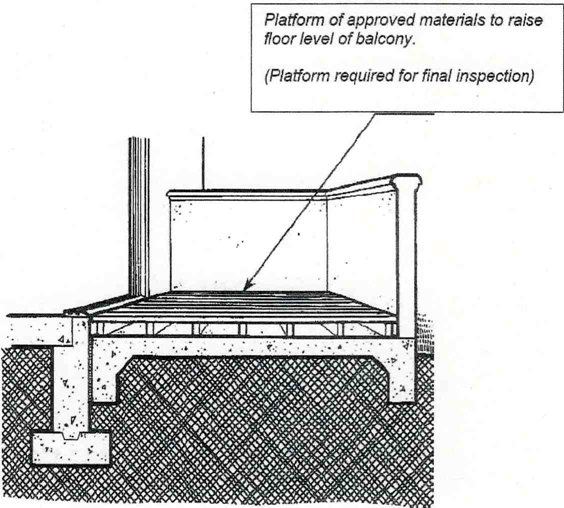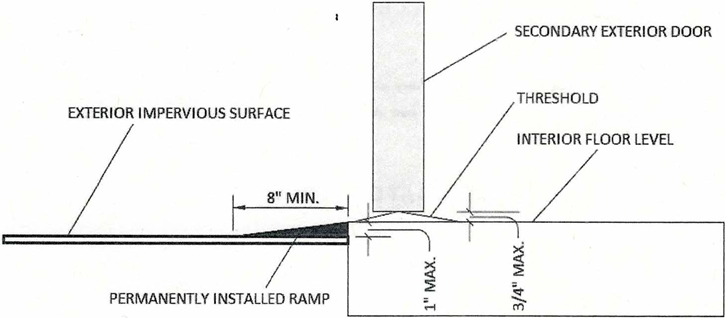2019 California Standards for Accessible Design Guide (effective January 1, 2020 with July 1, 2021 amendments)
SECTION 1132A DOORS
1132A.1 Primary entry doors and required exit doors.
The width and height of primary entry doors and all required exit doors shall comply with Section 1126A.1. The requirements of Sections 1126A.3 shall apply to maneuvering clearances at the side of the door exposed to common or public use spaces (e.g., entry or exit doors which open from the covered multifamily dwelling unit into a corridor, hallway or lobby, or directly to the outside).
1132A.2 Interior doors and secondary exterior doors.
Except as allowed by Section 1109A.2, interior doors intended for user passage and secondary exterior doors shall comply with this section. The provisions of this section shall apply to the dwelling unit side of doors leading from the interior of the dwelling unit to an unfinished basement or an attached garage.
1132A.3 Width and height of interior doors and secondary exterior doors.
Doors shall comply with the following:
- Doors shall not be less than 6 feet 8 inches (2032 mm) in height.
- Swinging doors shall provide a net clear opening width of not less than 32 inches (813 mm), measured with the door or doors positioned at an angle of 90 degrees from the closed position.
- Swinging doors shall be capable of opening at least 90 degrees.
- A nominal 32-inch (813 mm) clear opening provided by a standard 6-foot wide (1829 mm) sliding patio door assembly is acceptable.
- A pair of doors, manual or automatic, must have at least one leaf which provides a clear width of not less than 32 inches (813 mm), measured with the door positioned at an angle of 90 degrees from its closed position.
- The width of any component in the means of egress system shall not be less than the minimum width required by Section 1005.
1132A.4 Level floor or landing.
See also Chapter 10. The floor or landing on each side of a door shall be level. Primary entry doors, required exit doors or secondary exterior doors with changes in height between the interior surface or floor level and the exterior surface or floor level shall comply with the following:
- Exterior landings of impervious construction (e.g., concrete, brick, flagstone) serving primary entry doors and required exit doors are limited to not more than ½ inch (12.7 mm) of change in height between floor surfaces. Changes in level shall comply with Section 1131A.
- Exterior landings of pervious construction (e.g., wood decking with spaces) shall be the same level as the interior landing, except that secondary exterior doors may have no more than ½ inch (12.7 mm) of change in height between floor surfaces. Changes in level shall comply with Section 1131A.
- Secondary exterior doors onto decks, patios, or balcony surfaces constructed of impervious materials (e.g., concrete, brick, flagstone) may have a maximum change in height from the interior landing of 4 inches (101.6 mm). Changes in height greater than ½ inch (12.7 mm) shall be accomplished by means of a ramp complying with Section 1114A or by means of a platform constructed to the level of the floor as illustrated in Figure 11A-8J.

FIGURE 11A-8J
PLATFORM AT SECONDARY EXTERIOR DOOR
4. Secondary exterior doors onto decks, patios or balcony surfaces constructed of impervious materials (e.g., concrete, brick, flagstone) may have a maximum change in height from the interior landing of 1 inch (25.4 mm), provided a ramp with a maximum slope of 1:8 is permanently installed. (See Figure 11A-8K).

FIGURE 11A-8K
RAMP AT SECONDARY EXTERIOR DOOR
5. In buildings containing covered multifamily dwelling units, the floor or landing immediately outside the entry may be sloped up to ¼ inch (6.35 mm) per foot (12 inches) (305 mm), in a direction away from the primary entrance of the dwelling unit for drainage.
1132A.4.1 Thresholds.
Thresholds at the primary entry and required exit doors shall be no higher than ½ inch (12.7 mm). Thresholds at secondary exterior doors, including sliding door tracks, shall be no higher than 3/4 inch (19.05 mm). Changes in height at interior door thresholds (e.g., floor material changes at door thresholds) shall not exceed ½ inch (12.7 mm). Thresholds shall comply with the following:
-
Thresholds with a change in height of not more than ¼ inch (6.35 mm) may be vertical.
-
Thresholds with a change in height between ¼ inch (6.35 mm) and 3/4 inch (19.05 mm) shall be beveled with a slope no greater than 1 unit vertical in 2 units horizontal (50-percent slope).
1132A.5.1 General.
The floor or landing on the dwelling unit side of the primary entry door and any required exit door shall have a minimum length of not less than 44 inches (1118 mm). Section 1126A.3 shall apply to maneuvering clearances at the side of the door exposed to common or public use spaces.
Maneuvering clearances at interior doors shall provide a minimum length on both sides of the door of at least 42 inches (1067 mm) measured at a right angle to the plane of the door in its closed position.
Exception: A 39-inch (991 mm) length is acceptable at interior doors when a minimum clear opening width of 34 inches (864 mm) is provided.
1132A.5.2 Strike edge maneuvering space at doors.
The width of the level area on the side to which the door swings shall extend 18 inches (457 mm) past the strike edge for all doors. The width of the level area at the exterior side of the primary entry door and any required exit doors shall comply with Section 1126A.
Notes:
- See Section 1134A for bathrooms that are required to be accessible.
- Twenty-four inches (610 mm) is preferred for strike edge clearance.
1132A.6 Closer-effort to operate doors.
Maximum effort to operate doors shall not exceed 8½ pounds (38 N) for exterior doors and 5 pounds (22 N) for interior doors, such pull or push effort being applied at right angles to hinged doors and at the center plane of sliding or folding doors. Compensating devices or automatic door operators may be utilized to meet these standards. When fire doors are required, the maximum effort to operate the door may be increased to the minimum allowable by the appropriate enforcement agency, not to exceed 15 pounds (66.7 N).
1132A.7 Type of lock or latch.
The type of latch and lock required for all doors shall be in accordance with Section 1132A.8 and Chapter 10, Section 1008.
1132A.8 Hand-activated door hardware.
Hand-activated door latching, locking and opening hardware shall be centered between 30 inches (762 mm) and 44 inches (1118 mm) above the floor. Latching and locking doors that are hand-activated and on an accessible route shall be operable with a single effort by lever-type hardware, panic bars, push-pull activating bars or other hardware designed to provide passage without requiring the ability to grasp the opening hardware. Locked exit doors shall operate consistent with Section 1132A.6, in the direction of egress.
1132A.8.1 Lever-type hardware.
The lever or lever of actuated latches or locks shall be curved with a return to within ½ inch (12.7 mm) of the door to prevent catching on the clothing of persons during egress in Group R and U Occupancies with an occupant load greater than 10.
1132A.9 Smooth surface.
Swinging door or gate surfaces within 10 inches (254 mm) of the finish floor or ground measured vertically shall have a smooth surface on the push side extending the full width of the door or gate. Parts creating horizontal or vertical joints in these surfaces shall be within 1/16 inch (1.6 mm) of the same plane as the other and be free of sharp or abrasive edges. Cavities created by added kick plates shall be capped.
Exceptions:
- Automatic doors.
- Tempered glass doors without stiles and having a bottom rail or shoe with the top leading edge tapered at 60 degrees minimum from the horizontal.
- Doors or gates that do not extend to within 10 inches (254 mm) of the finish floor.
1132A.10 Door signal devices.
Every primary entrance to a covered multifamily dwelling unit shall be provided with a door buzzer, bell, chime or equivalent. The activating mechanism shall be mounted a maximum of 48 inches (1219 mm) above the floor and connected to permanent wiring.

User Comments/Questions
Add Comment/Question